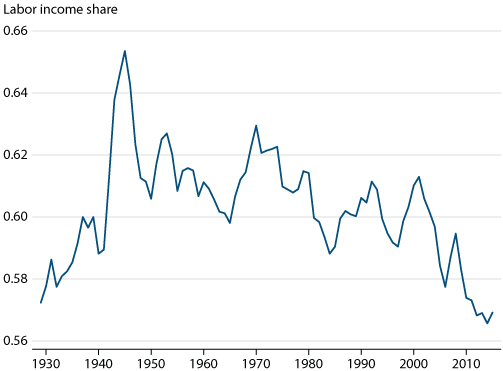Why Is the Labor Share Declining?
Abstract
The fraction of national income accruing to labor (the labor share) had been roughly constant in developed economies for much of the 20th century but has fallen since the 1980s. We review several of the leading explanations in the literature for the declining labor share. We then point to hitherto unexplored dimensions of the data and provide suggestive evidence for a new explanation. In particular, we show that the labor share began a steeper descent in 2000. This more recent break in the labor-share trend coincides with the rapid rise of software investment, which has left a larger impact on service industries (than manufacturing) and on high-skill, cognitive occupations (than middle-skill, routine occupations).
Sangmin Aum is an assistant professor of economics at Myongji University. Yongseok Shin is a professor of economics at Washington University in St. Louis and a research fellow at the Federal Reserve Bank of St. Louis. The authors thank the Review editor-in-chief and an anonymous referee for their helpful editorial suggestions.
INTRODUCTION
For much of the 20th century, the fraction of national income accruing to labor (the labor share, hereafter) remained more or less constant over time, at least in developed economies. Keynes (1939, p. 48) wrote that "the stability of the proportion of the national dividend accruing to labour" was "one of the most surprising, yet best-established, facts in the whole range of economic statistics, both for Great Britain and for the United States." Phelps Brown and Hart (1952) confirmed this fact, which was then cited by Kaldor (1957) and became widely known as one of the six Kaldor facts of economic growth. Although it is true that the labor share did not have an obvious long-term trend, it did exhibit deviations from its long-run level that lasted over a decade, a fact Kaldor was aware of. For example, he cited the medium-run trends in the labor share in the 1930s, as documented by Kuznets (1952).
The labor share in the United States started to decline following its post-war peak in 1970 but, as Figure 1 shows, occasional reversals make it hard to precisely point out the beginning of the downward trend.

Figure 1
Labor Income Share in the United States
NOTE: Labor income share is the compensation of employees divided by gross domestic income. Proprietors' income is adjusted assuming that its labor share is the same as the labor share in the rest of the economy.
SOURCE: Authors' calculations based on data from NIPA.
In any case, economists did not pay much attention to the emerging downward trend in the labor share through the 2000s. It was only in the aftermath of the 2007-09 Financial Crisis, with heightened interest in economic inequality, that the falling labor share made headlines. The early contributors were Elsby, Hobijn, and Sahin (2013); Karabarbounis and Neiman (2013); and Piketty (2014), whose work motivated many other researchers to propose various explanations for the phenomenon.
Here we provide an overview of the proposed explanations. It is not meant to be an exhaustive list of all the papers on this topic. Rather, we focus on the three distinct, broad approaches that emerged in the literature.
Read the full article.


 follow @stlouisfed
follow @stlouisfed